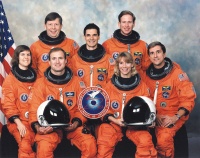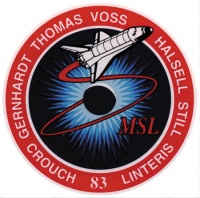STS-83
From The Space Library
 | |
| Organization | NASA-Office of Space Flight (United States) |
|---|---|
| Mission type | Human Crew,Life Science |
| Launch date | April 4, 1997 |
| Launch vehicle | Space Shuttle |
| Launch site | Cape Canaveral, United States |
| COSPAR ID | 1997-013A |
| Inclination | 28.45 degrees |
| Experiments | Here |
| Alternate Names | 24755 |
| Additional Information | Here |
| Data Collection | Here |
| Payload Mass Up | 11580.21 kg |
| Payload Mass Down | 11604.55 kg |
| Orbiter | Columbia |
| Lift Off Mass | 2,055,943.64 kg |
| Orbiter Weight at Liftoff | 118,148.64 kg |
| Orbiter Weight at Landing | 96,845.45 kg |
| Landed | Concrete runway 33 at Kennedy Space Center, Fla. |
| Orbits of Earth | 63 |
| Orbital Altitude | 160 nautical miles (184 statute miles) |
Contents |
[edit] Crew
- Commander: James D. Halsell Jr.
- Pilot: Susan L. Still
- Payload Commander: Janice Voss
- Mission Specialist 1: Donald A. Thomas
- Mission Specialist 2: Michael L. Gernhardt
- Mission Specialist 3:
- Mission Specialist 4:
- Mission Specialist 5:
- Payload Specialist 1: Gregory T. Linteris
- Payload Specialist 2: Roger K. Crouch
ISS/Mir Crew Transport
[edit] Mission
The primary payload on STS 83 was the Microgravity Science Laboratory (MSL), a collection of microgravity experiments housed inside a European Spacelab. First flight of the MSL was cut short due to concerns about one of three fuel cells, marking only the third time in Shuttle program history a mission ended early. (STS-2, 1981 and STS-44, 1991 were the other two times). Fuel cell No. 2 had shown some erratic readings during prelaunch startup, but was cleared to fly after additional checkout and test. Shortly after on-orbit operations began, the fuel cell no. 2 substack no. 3 differential voltage began trending upward. There are three fuel cells on each orbiter, each containing three substacks made up of two banks of 16 cells. In one substack of fuel cell no. 2, the difference in output voltage between the two banks of cells was increasing. The fuel cells use a reaction of liquid hydrogen and liquid oxygen to generate electricity and produce drinking water. Although one fuel cell produces enough electricity to conduct on-orbit and landing operations, Shuttle flight rules require all three to be functioning well to ensure crew safety and provide sufficient backup capability during reentry and landing. When a purge failed to halt the upward trend, the fuel cell was shut down. Additional purges and other measures failed to correct the anomaly, and around 10 a.m., April 6, the Mission Management Team ordered the mission to end early. Fuel cell no. 2 was shut down for good later that afternoon and safed. The crew was able to conduct some science in the MSL-1 Spacelab module despite the early return. Work was performed in the German electromagnetic levitation furnace facility (TEMPUS) on an experiment called Thermophysical Properties of Undercooled Metallic Melts. This experiment studies the amount of undercooling that can be achieved before solidification occurs. Another experiment performed was the Liquid-Phase Sintering II experiment in the Large Isothermal Furnace. This investigation uses heat and pressure to test theories about how the liquefied component bonds with the solid particles of a mixture without reaching the melting point of the new alloy combination. Also conducted were two fire-related experiments. The Laminar Soot Processes experiment allowed scientists to observe for the first time the concentration and structure of soot from a fire burning in microgravity. The Structure of Flame Balls at Low Lewis-number experiment completed two runs. This experiment is designed to determine under what conditions a stable flame ball can exist, and if heat loss is responsible in some way for the stablilization of the flame ball during burning. A decision to refly the mission in its entirety was made by the Mission Management Team in the days following Columbia's return. The reflight was first designated STS-83R and then renamed STS-94.
[edit] EVA
[edit] Payload
Microgravity Science Laboratory (MSL) 01; Spacelab module with long crew transfer tunnel; extended-duration orbiter cryogenic pallet; Cryogenic Flexible Diode Heat Pipe Experiment (CRYOFD); Orbital Acceleration Research Experiment (OARE); Protein Crystal Growth (PCG) - Single-Locker Thermal Enclosure System (STES); Shuttle Amateur Radio Experiment (SAREX) II; Midcourse Space Experiment (MSX) The mission was cut short by shuttle managers because of a problem with fuel cell No. 2, which displayed evidence of internal voltage degradation after the launch.
[edit] Books about the Space Shuttle Program
Buy This Book Click here |
Buy This Book here |
Buy This Book Click here |
Buy This Book Click here |





